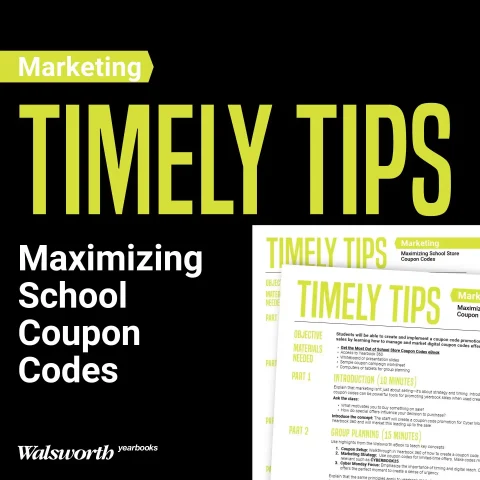The yearbook theme is the heartbeat of your publication. It’s the unifying thread that weaves together the diverse stories, events and personalities of the school year into a cohesive and memorable narrative. More than just a catchy slogan on the cover, a strong theme provides verbal and visual direction, influencing everything from headlines and captions to color palettes and typography.
Developing that perfect theme, however, can feel daunting. Where do you even begin? How do you move from abstract ideas about the school year to concrete, usable phrases?
Our latest Timely Tips lesson plan provides a roadmap for guiding your staff through the crucial initial stages of brainstorming and developing theme phrases and related verbal spin-offs. Designed to be completed in roughly 30 minutes of class time, it encourages students to think critically about their school community and translate those insights into powerful thematic language.
You’ll need access to yearbook theme examples (such as the Walsworth Yearbooks Theme Gallery, a printed copy of the Possibilities book or your library of past yearbooks from yourself or other schools) to show as examples when explaining these concepts
Defining a Theme’s Purpose
Begin by establishing a shared understanding of what a yearbook theme truly entails. Explain to your staff that it’s the core concept driving the book’s story. It needs to be more than just a clever title; an effective theme must be:
- Relatable: Students, faculty and staff should see themselves and their experiences reflected in it.
- Specific: It should capture the unique essence of this school during this particular year. What makes this year different?
- Authentic: It must genuinely represent the school’s culture, mood and significant happenings. Avoid generic phrases that could apply to any school, any year.
Clarify how the theme acts as connective tissue, linking disparate sections like academics, sports, student life and clubs. It provides both verbal cues (through phrases and spin-offs) and visual cues (through design elements) that create a unified reader experience.
Adviser Tip: Use concrete examples. Show covers, divider pages and spreads from strong yearbooks (using resources like the Walsworth Theme Gallery or your own collection). Point out exactly how the theme is woven verbally and visually throughout the book. Discuss why those themes were effective for those specific schools and years.
Mix and Match Activity
To underscore the crucial link between verbal and visual elements, try this quick exercise. Select two distinct theme examples from past yearbooks. Ask students to imagine taking the verbal theme (the main phrase and spin-offs) from Book A and applying it to the visual theme (design, colors, fonts) of Book B.
Facilitate a brief discussion using prompts like:
- Does the theme still work effectively when the visuals change? Why or why not?
- How did the different visual presentation alter your perception of the verbal theme?
- If you had to make this mash-up work, what adjustments would be necessary?
This activity helps students recognize that verbal and visual components must be developed cohesively to support and enhance each other.
Brainstorming Core Concepts
Now, shift the focus to your school. Lead a dynamic group brainstorming session aimed at uncovering the unique characteristics and anticipated experiences of the upcoming school year. Record all ideas prominently on the whiteboard or projector without judgment.
Use guiding questions to stimulate discussion, focusing on areas such as:
- School Identity: What defines your school? Consider traditions, mascot, location, specialized programs, student lingo, school spirit (or lack thereof), rivalries and community perception.
- Anticipated Future: What’s on the horizon? Think about new construction, building anniversaries, major curriculum changes, significant school events, anticipated challenges or triumphs.
- Student Experience: What words or feelings characterize daily life for students? Is it fast-paced, diverse, collaborative, competitive, stressful, supportive, innovative? What are the common joys and struggles?
- Relevant Narratives: How do broader teen experiences manifest uniquely at your school? How do students connect, communicate and navigate their academic and social lives here?
Adviser Tip: Encourage broad participation. Capture specific words, phrases and anecdotes. The goal here is quantity and authenticity, not polished theme statements.
Crafting Theme Phrases and Spin-offs
With a rich pool of ideas generated, it’s time to start shaping them.
- Concept Grouping: Have students (perhaps in small groups) review the brainstormed list and identify two or three recurring concepts or broad ideas that feel particularly relevant and authentic for the upcoming year. Focus on capturing the essence.
- Modeling Phrase Development: Select one or two promising concepts from the class discussion. Model how to translate these broad ideas into potential theme phrases. Show how one concept can lead to multiple phrase options with different angles or tones. Emphasize that these phrases should ideally be short, memorable and flexible enough to apply across various sections.
- Introducing Spin-offs: Explain the vital role of verbal spin-offs – related words or short phrases derived directly from the main theme phrase. These are the tools used in headlines, captions, section titles and feature mods to consistently reinforce the theme. Model creating several spin-offs for the example theme phrase you developed. If time permits, show examples from published yearbooks, highlighting how spin-offs connect content back to the central idea.
Adviser Tip: Remind students that spin-offs add depth and prevent the main theme phrase from becoming repetitive. They allow for creative application of the theme to specific stories.
Keep the Momentum Going
Conclude the lesson by assigning a clear follow-up task. Have each student (or small group) choose one promising theme concept identified during the session. Their task, for homework or the next class period, is to:
- Draft two to three potential theme phrases based on that concept.
- Brainstorm five to 10 related spin-off words or short phrases.
- Briefly consider how these verbal elements could tell a cohesive story throughout the yearbook.
This assignment encourages students to take ownership of the ideas and begin the critical work of refining the theme’s verbal identity. It sets the stage for further development, including visual exploration and eventual selection of the final theme.
By dedicating focused time to this foundational step, you empower your staff to move beyond surface-level slogans and develop a yearbook theme that is truly representative, engaging and memorable for your school community.





